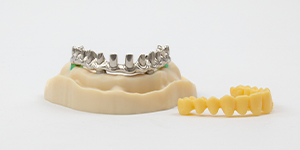1.1.1 Telescopic crown principle
The telescopic crown principle is at the heart of telescopic technology and a key component in modern dental prosthetics, offering an innovative solution for replacing lost teeth. This principle is based on a precise and sophisticated methodology that uses two types of crowns: the primary crown and the secondary crown. Together they form a unique system that allows for both fixed and removable tooth replacement, achieving an optimal balance between stability and flexibility.
Primary crowns: The primary crown, often made of high-quality, durable materials such as non-precious metals or zirconium dioxide , is placed directly on the prepared tooth stump and cemented there. Its main task is to serve as a stable base on which the secondary crown can slide. The surface of the primary crown is designed to provide optimal retention for the secondary crown without damaging the natural tooth or exerting excessive pressure.
Secondary crowns: The secondary crown, which is part of the removable prosthesis, is placed over the primary crown and can be removed by the patient when necessary. It is usually made of a similar or compatible material as the primary crown to ensure a smooth interaction. The inner surface of the secondary crown is precisely molded to the outer contour of the primary crown to achieve an exact fit. This interaction allows the prosthesis to sit securely on the primary crowns without any play, ensuring a high level of comfort and functionality for the wearer.
The combination of primary and secondary crowns in the telescopic crown principle offers several decisive advantages. It enables seamless aesthetics, as the prosthesis looks natural and blends harmoniously into the overall appearance of the teeth. It also offers excellent durability and reliability, as the prosthesis fits firmly but can still be easily removed for cleaning purposes. Furthermore, this principle helps to preserve the remaining tooth substance, as the natural teeth not only serve as a support for the denture, but are also protected by the even distribution of the chewing forces.
Overall, the telescopic crown principle represents a significant innovation in dental prosthetics, making it possible to meet individual patient needs and requirements with a high degree of precision and aesthetics. It symbolizes the advances in dental technology that offer an improved quality of life for people with dentures.
1.1.2 Materials and manufacturing process
The choice of materials for telescopic crowns is crucial for the longevity and functionality of the prosthesis. Modern telescopic crowns are made from a variety of materials, including gold alloys, non-precious metal alloys and zirconium dioxide , which are known for their biocompatibility and wear resistance. The manufacturing process benefits enormously from CAD/CAM-technologies, which enable a millimeter-precise fit.
1.1.3 Advantages and disadvantages
The advantages of the telescopic technique include excellent aesthetics, a precise fit and the ability to preserve natural teeth. A possible disadvantage could be the higher price compared to other tooth replacement options, but this is justified by the durability and quality of the solution.
